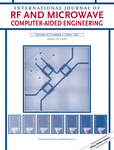Polarization-insensitive frequency selective rasorber with broad absorption band and two-sided transmission bands
Abstract
In this study, a compact and polarization-insensitive frequency selective rasorber (FSR) is proposed with dual transmission bands located at the two sides of a broad absorption band. The proposed FSR is a two-layer structure designed by combining the Jerusalem cross based dual bandpass frequency selective surface (FSS) with a broadband resistive square loop absorber, such that both the absorption and transmission characteristics are retained. The proposed FSR has a thickness and size of 0.09λL and 0.026λL2, respectively at the lowest frequency of −10 dB reflection (1.97 GHz). The dual transmission bands are obtained at 2.1 and 8.8 GHz with an in-between absorption band ranging from 3.6 to 7.4 GHz (69.09%). The working principle of the proposed FSR is analyzed using an equivalent circuit model. Furthermore, a range of lower and upper transmission bands with respect to the absorption band is determined by carrying out the parametric studies on the geometrical parameters of the bandpass FSS. A prototype of the proposed FSR consisting of an array of 10 × 10 unit cells is fabricated and the results are experimentally verified.
Open Research
DATA AVAILABILITY STATEMENT
The data that supports the findings of this study are available in the supplementary material of this article.




